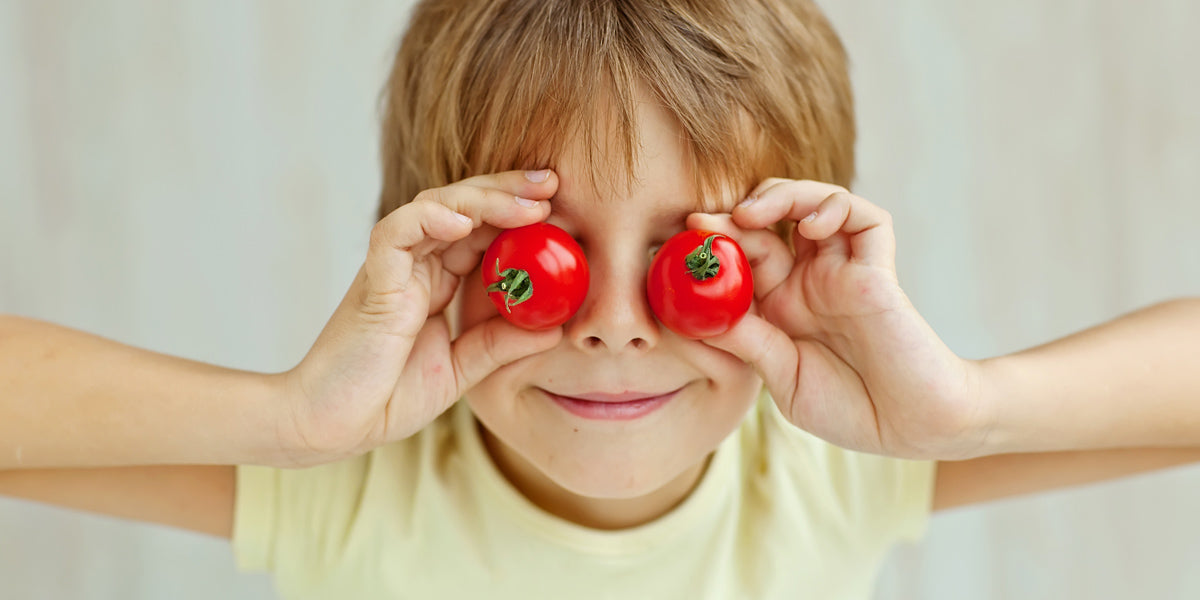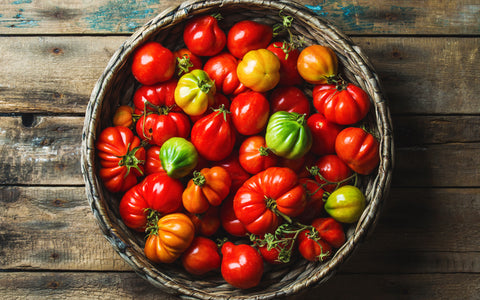
How 4 Carotenoids in Tomatoes Help You See Better
Most nutritionists and health-focused eaters will tell you that a stand-out health component of tomatoes is lycopene, an antioxidant-rich carotenoid that is unique to red-pink produce.
But what most experts fail to mention is that tomatoes are one of very few fruits and vegetables that contain all four major carotenoids: lycopene, alpha-carotene, beta carotene, and lutein. This is special and noteworthy because those compounds have synergy that creates more antioxidant activity together than the sum of those individual compounds would. Let’s break it down and then put it all back together.
What are carotenoids?
They sound a bit otherworldly, but carotenoids are very much of this earth. They are natural plant chemicals that help all kinds of plants absorb light so they can grow and thrive. Carotenoids act as powerful antioxidants in both plants and humans, which means they deactivate free radicals, which are damage-causing, single-oxygen atoms often responsible for inflammatory diseases and cancers.
Which foods have the most carotenoids?
Carotenoids are found in warm colored produce: Think reds, oranges, dark yellows, and deep pinks. The following foods contain some of the highest amounts of carotenoids:
- carrots
- cantaloupe
- sweet potatoes
- papaya
- pumpkin
- tangerines
- tomatoes
- winter squash

Why people need carotenoids
In humans, carotenoids that we get from bright red, pink, orange, and yellow foods have a strong antioxidant effect. Our bodies create their own antioxidant defenses to help keep harmful free radicals at low levels. But you also get and need antioxidants from the foods you eat. Research shows that eating a diet full of antioxidant-rich foods increases your blood levels of antioxidants.
The main reasons we need carotenoid antioxidants, specifically, is because of their effect on lowering inflammation and enhancing our immune systems. Here’s help for understanding how the four main types of carotenoids show up in tomatoes, and how they benefit us.
Alpha-Carotene in Tomatoes
Alpha-carotene (like beta-carotene) converts to vitamin A in your body. Alpha-carotene is far less common in foods than beta-carotene is, but tomatoes are a great source of both. Some epidemiological studies observed that higher alpha-carotene intake was associated with lower risk of cardiovascular disease and cancer.
Alpha-carotene and beta-carotene are both fat soluble nutrients, which means that they need to be ingested with some fat in order for your body to absorb them properly. This is why it’s great that Otamot sauces contain extra-virgin olive oil, and healthy fat that increases the absorption of so many of the other great nutrients in each jar.
Beta-Carotene in Tomatoes
Similar to alpha-carotene (though a lot more abundant in foods), beta-carotene is a precursor to vitamin A. This means our bodies take in beta-carotene and convert it into an essential vitamin that we need for vision and eye health, healthy skin, brain function, and a strong immunity.
The strong antioxidant effect of carotenoids like beta-carotene are why you may experience better cognitive function (like stronger memory), better skin appearance, and lowered risk of eye conditions, such as blurriness, vision loss, and age-related macular degeneration after eating carotenoid-rich produce.
Lutein in Tomatoes
This special type of carotenoid is mostly associated with eye health, and specifically acts as a filter to protect eyes from damaging light and oxygen.
Lutein has been in the spotlight more recently because of its potential ability to combat eye damage from blue light, the kind emitted from your smartphone, tablet, TV, and even energy-efficient light bulbs. Blue light has been known to trigger eyestrain and contribute to worsening eye health, poor sleep, and even mood disorders.
Lutein is often associated with another eye-supporting antioxidant called zeaxanthin, and together these two nutrients pack a protective punch for your eyes. Some small studies have shown that regular intake of lutein and zeaxanthin over months reduces eye strain, poor sleep, and headaches caused by excessive blue light screen time.
Yet another great thing about Otamot being made from 10 organic veggies is that it contains ingredients that supply BOTH lutein and zeaxanthin (from the tomatoes, carrots, bell pepper, sweet potato, butternut squash, and spinach) in amounts significant enough to supply protective antioxidants against harmful blue light.
Lycopene in Tomatoes
Lycopene and tomatoes go together like peanut butter and jelly, making each other just that much better. One of the coolest things about lycopene is that it increases as tomatoes get heated and cooked, which is why tomato sauce is one of your top sources of lycopene.
Like other carotenoids, lycopene is a strong antioxidant that can protect you from environmental toxins, improve eye and skin health, reduce the risk of some cancers, and even have a reducing effect on neuropathic pain.

The Whole is Greater Than The Sum of Its Parts
As a registered dietitian, it is tempting to break down nutritious foods (like tomatoes) into a laundry list of nutrients and health benefits. But it’s equally important to mention that the whole is always greater than the sum of its parts. Allen Lim, Ph.D., an exercise physiologist who works with pro cyclists, once told me: “There are literally hundreds of compounds in a tomato that benefit our health. And, as much as we might highlight one or two, the reality is that the benefit of any single component occurs in the context of the whole tomato. Thus, the most important ingredient in a tomato is the tomato itself. Like most edible whole fruits and plants, the benefits are self-evident.”
I think about that often, and was reminded of it again here when writing about the individual carotenoids in tomatoes. One thing that makes tomatoes so unique and special is that it contains a ton of powerful antioxidants (including the four main carotenoids listed above). And when all of those antioxidants get together, they are stronger. They show up together and throw a loud nutrient party as they make their way through your body, dancing their way to build up your organs and throwing any unwanted guests (those pesky free radicals) to the curb. Party on, carotenoid clan!

Jessie Shafer is a registered dietitian-nutritionist, team member at The Real Food Dietitians, former magazine editor, and busy mom of two who loves to remind people that veggies are greater than the sum of their parts.

